Jauja, the new film by Argentine director Lisandro Alonso, is a work of singular grace and mystery. Set against the deceptive beauty of 19th-century Patagonia and composnt: 2em;”ed in saturated, old-world color, it stars Viggo Mortensen as a Danish engineer roaming the barren landscape in search of his missing daughter—a strange journey that appears to lead him to the edge of time itself. In this interview, Alonso discusses the perils of explaining the film’s narrative, his decision to project in an unusual, rounded-frame Academy ratio, and the idea behind that ending. (Warning: there are sort-of spoilers.)
MOVIE MEZZANINE
Jauja is a cinema of dream, in that it doesn’t lend itself to one specific interpretation—which is great, because so much of movie culture these days is “explain this,” or “give us the backstory.” Is it important for you to approach a film in this way, to permit different perspectives?
LISANDRO ALONSO
Well, I never like those kinds of films, where I can follow a plot. I never think in those terms. You can take different ways to interpret the film, but I thought that the film was, in a way, very simple. But when you try to explain a film, it gets complicated. In a way, you can say that it’s about a father looking for his daughter in the middle of nowhere, some time ago, back in Patagonia, in those times where the military, the people from the government, killed the Indians. But the film itself, in a way, it’s like a fábula, a fairy tale.
MOVIE MEZZANINE
Do you resist an explanation of the film?
LISANDRO ALONSO
I think it has its own explanation without trying to get information from other places. I don’t like to explain many things, I just prefer to observe people and places, how they interact. I try to show things and let people figure out what is happening in the heads of the characters, what is happening around them, and how they try to control the situation, if they can. What the characters need or how alone they feel, how they feel the solitude. I think that’s it. I don’t ask myself many things when I start thinking about a film.
MOVIE MEZZANINE
Was there a specific image, or idea, that lead you to develop this story?
LISANDRO ALONSO
I was observing different kinds of places in Argentina where I wanted to shoot, and I had to involve some characters in those places, just in order to create a film. So we started thinking, “How can we shoot these places without having to put some cars and mobile phones in it?” To try to go back to those places in primitive times, you know—because the places are very rude. There’s nothing around those places nowadays. If I put a character in the middle of that place, it should be confusing for me. Then I started to think about the old times, and all these people from outside after the Spanish guys arrived to this kind of country and started thinking they could organize these new people and new land. And suddenly I go back in time, in terms of thinking “Okay, why not?” My friend Fabian Casas, the co-writer, is a very close friend of Viggo—and I immediately thought of him talking Danish, because it was going to be more unique for the character, for the daughter, and for the film itself.
MOVIE MEZZANINE
It’s hard to imagine anyone being as great as Viggo. Since he and Fabian were friends, was there a point where you started shaping the movie for Viggo?
LISANDRO ALONSO
I always thought about Viggo to make this film, but that was only in my head, you know—Viggo didn’t know anything about that.
MOVIE MEZZANINE
Why Viggo?
LISANDRO ALONSO
For me, it was ever since I saw the film he made with Cronenberg, A History of Violence. I really liked him as an actor. Then I met him in 2006, in Toronto for the film festival, and we just spent a couple of minutes together at a party. I’d never before worked with actors, because I thought… Well, I have some wrong ideas about some of them. [Laughs] Not all of them, but some of them.
MOVIE MEZZANINE
Not all of them are like Viggo, that’s part of the problem.
LISANDRO ALONSO
Well, he’s a very unique guy. He’s really involved with a lot of art things, and he’s an informed guy. He tries to push the art he likes to someone else—even if he knows with a film like this that it’s not going to be a big success. If he wants to get involved, he will support the film. He was a producer, an actor, he created the music, and he’s been involved in almost every screening. He’s traveling a lot with the film and I love that. He was the first one to wake up and try to organize the crew. I really learned a lot from him. He’s a worker, you know, a machine, all the time thinking good things for the project. Sometimes he was too much for me, because I was not used to that. I was used to working with people who don’t know how to read or write, you just organized a little bit of the frame, and that was it. But with Viggo, you have to talk about why you wanna do that, in terms of where to put the camera and the lights, you know.
MOVIE MEZZANINE
What about in terms of his character? Did he want to know more about him?
LISANDRO ALONSO
To be honest, I didn’t speak much about that. He’s a great actor and I’m a new guy, in terms of actor’s stuff, so I think I had to sit down and learn from him. I didn’t speak that much, and I think Viggo knows 100 percent how to interpret this guy. I don’t even understand a word when they talk Danish. [Laughs]
MOVIE MEZZANINE
The framing of the film is very deliberate. It reminded me of the world’s slowest, moodiest Viewmaster reel. What was your reason for projecting it in rounded-edge 4:3?
LISANDRO ALONSO
Actually, it was a coincidence and I took advantage of it. We composed the whole film in 1:85 during the shooting, and once we’d finished, I discovered that the people from the lab sent me the image with the wrong matte. So I asked them if they could take it out and just send me the image as a full frame, as you get it from the transfer machine. I started to edit it in that way. That’s the same image that I received from the lab. Suddenly, I started thinking, “Okay, why not?” This should be like in the old days, the old movies, and I started thinking that for this film it was a better perspective, because it reminds me of some other period in the history of cinema. I also liked it because I filmed more of the skies and the land, and how this guy is in the middle of the landscape, and I thought it was better to show it that way, rather than the panoramic image. Because with Viggo and the rifle and the horse, perhaps some people are waiting for some more action, but that’s not the kind of film that we’re doing. So I think from the very beginning, you feel that this is going to be something different from what you’d expect if you’re going to see a Viggo Mortensen film.
MOVIE MEZZANINE
A few people, including Viggo, have likened Jauja to Tarkovsky, or talked about John Ford. For me, at least in terms of the ending, it had an almost late-Buñuel feel to it. I’m curious if you had other films in mind when you were making it, or if there’s anything that perhaps rubbed off on you—apart from your own work, of course?
LISANDRO ALONSO
I see many different kinds of movies, and some by the filmmakers you just mentioned, but once I started to shoot, I don’t know why, but I disconnect from all the information, in a conscious way, so I don’t think about any other movie in what we’re doing. I don’t think too much in terms of, “Okay, let’s frame it like this, because it reminds me of…” because I think the bigger influence I have when we’re shooting is from the people who are surrounding me—in this case Viggo, and especially the DP for the film, Timo Salminen, who worked a lot with Aki Kaurismäki. I was influenced a little bit by the last two or three movies by Kaurismäki, the way he dealt with history in terms of framing and lighting—which is, in a way, a little bit like Chaplin. In Chaplin, what I’m trying to say, is that it’s quite artificial, you know? All that’s happening is like theater. It’s artificial lighting, and you can feel the set, you know? We were shooting in natural places, but in the same way the lighting was very artificial, like as if you were on a set, so it created a kind of new atmosphere in the image. I think this is quite new for me.
So when people ask me, “Have you seen The Searchers?” No, I did not. But now—like, two weeks ago—I started to see the John Ford Western films, which I like a lot. But I hadn’t seen The Searchers, even if I knew that it had some similar plot elements to this one. But like I said, the biggest influence is the people on the set, the environment. I mean, I’m the one that’s talking now, but even if you recognize some influence then maybe that’s a fact—but maybe it doesn’t come from me, it comes from some other people. For example, the first image from the film isn’t even my idea—it’s the sound designer’s.
[Spoilers follow.]
MOVIE MEZZANINE
That’s interesting, because it’s such a distinct, powerful image.
LISANDRO ALONSO
Yeah. I mean, I’ve been working with him for 14 years. The guy just arrived [on set] and said “Lisandro, I think you should do this, and that,” and I think, “Okay, why not.” For example, in the script, the last part, which happens in Denmark, was at the beginning, but I realized that having it at the beginning doesn’t work that well, so I put it at the end, and I think that provoked a bigger surprise—to discover this old castle, and the garden, and the guy with the dogs, and the girl. You see the girl—again—but she’s in another time and space.
MOVIE MEZZANINE
So the ending was always part of your original idea?
LISANDRO ALONSO
Yeah, but it was at the beginning, which I think wouldn’t have worked that well because it would seem too easy—like the girl is probably dreaming, which doesn’t work that well. But the idea in the script was always that the film should have two times, and two girls—the same actress, but interpreting two different times.
MOVIE MEZZANINE
Do you think that they’re different girls, or the same girl inhabiting two dimensions in time and space?
LISANDRO ALONSO
No idea, I mean—
MOVIE MEZZANINE
I don’t want you to over-explain it, I’m just curious.
LISANDRO ALONSO
No, no, no, I’m curious too! I finished the film over a year ago and I’m still curious: Who is the second girl? Who is the first girl? Which one should I believe, you know?
MOVIE MEZZANINE
Well, that’s the thing about the film. Either could be a manifestation of the other’s mind… Or not.
LISANDRO ALONSO
I think it’s important that you feel that both of them can be real in the film. None of them are fake. And if the film made that happen, that’s a good thing for the film. That was our idea from the beginning, even if I don’t have any solution to that dilemma, or enigma, or whatever you want to call it. I don’t even know who the old lady in the cave is, you know? The important thing for me was, if you have someone who you really care about who disappears, I would like to think that in some way, in some place, we are still surrounded by them. That’s probably the major idea I had at the beginning. That’s how all these same/different characters appear in the script, as a way to find out if we can show that without being stupid, you know, without being silly.

















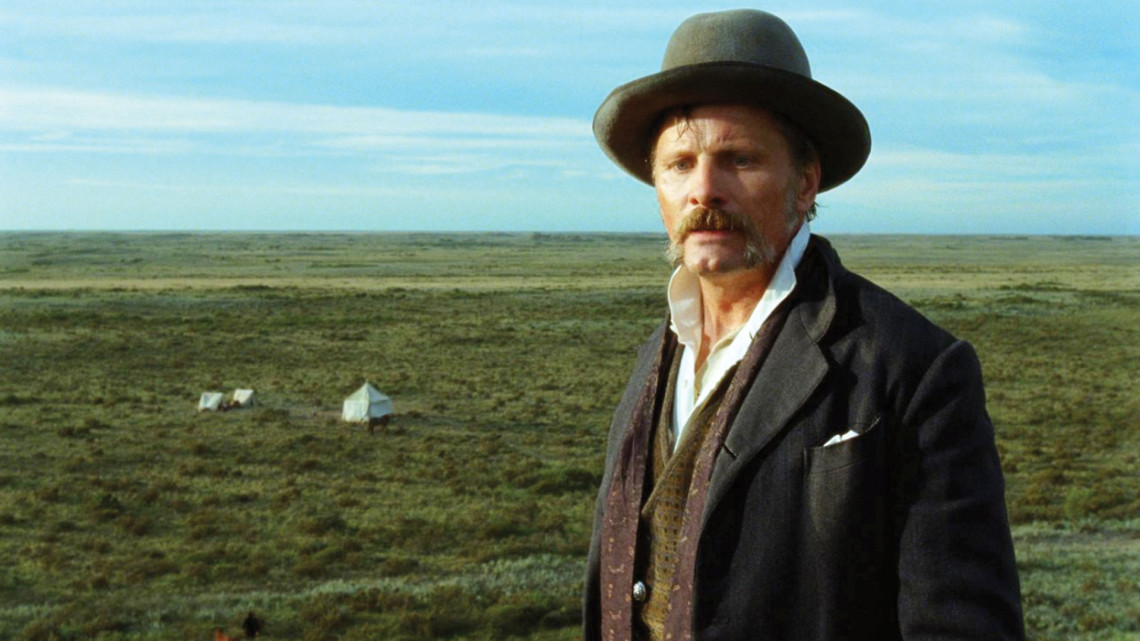
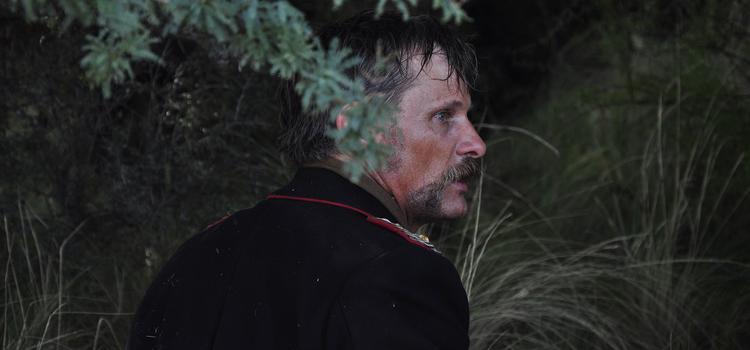
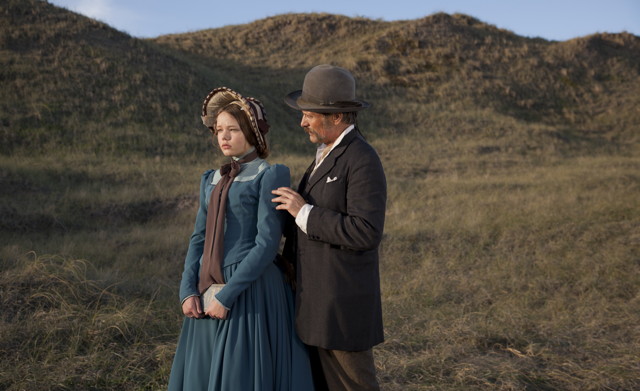
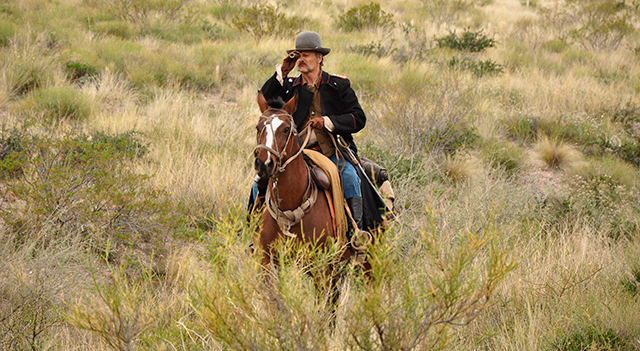
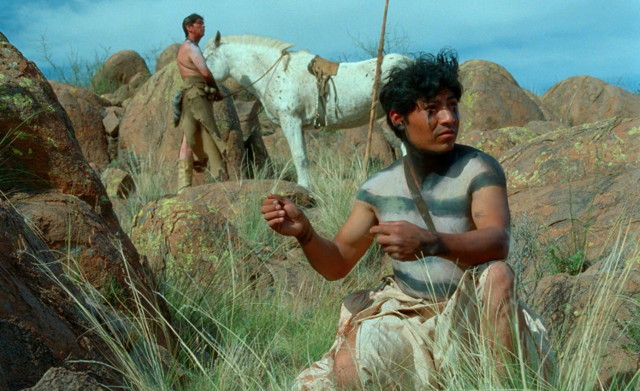
One thought on “Lisandro Alonso On “Jauja,” Viggo Mortensen, and Narrative Mysteries”
Pingback: Interview: Lisandro Alonso on “Jauja” | Luke Goodsell